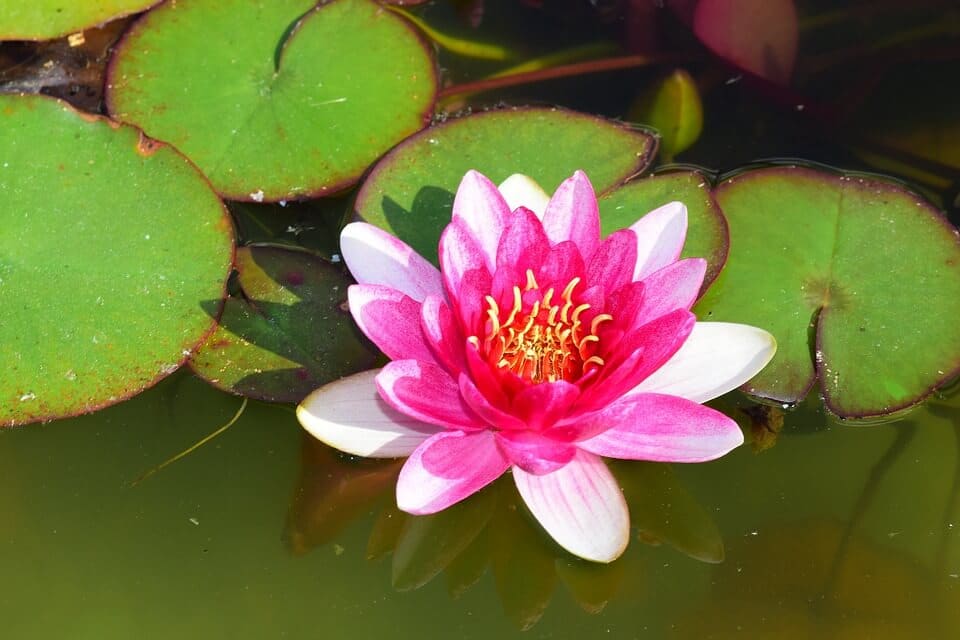A pond graced with water lilies is a sight to behold. Their vibrant flowers floating elegantly on the surface bring life and beauty to backyard ponds and water gardens. I’ve been fascinated with water lilies for years, and in this article I’ll explore their allure, different varieties, how to plant them, and tips for care.
The Timeless Appeal of Water Lilies
Water lilies have enchanted people for centuries with their tranquil, symmetyrical beauty. Here are some of the qualities that make them so captivating
-
Stunning flowers – Lily blooms range from small and delicate to large and showy coming in white pink, yellow, red, blue, and purple. Some open wide during the day and close at night.
-
Lily pads – The floating, circular leaves provide great texture and interest. Their size can vary from a few inches to over two feet wide.
-
Fragrance – Many lilies emit a lovely, light fragrance. Sitting by a pond, you may catch a whiff of their sweet scent.
-
Reflections – Lily pads and flowers reflect sunlight and create mesmerizing patterns on the water. This contributes to the relaxing, Zen-like atmosphere lilies evoke.
-
Natural appeal – Unlike flashy artificial decor, water lilies have an authentic beauty and help create a balanced ecosystem.
Types of Water Lilies
There are over 70 species of water lilies, with hundreds of hybrid varieties. Here are some of the main types available:
-
Hardy lilies – Tropical lilies die back and require winter protection in cooler climates. But hardy lilies survive winters and bloom annually. Popular hardy lily varieties include ‘James Brydon’, ‘Pink Sensation’, and ‘Gonnere’.
-
Day bloomers – These lilies open in the morning and close in the evening. Some examples are ‘Denver’, ‘Comanche’, and ‘Arc-en-Ciel’.
-
Night bloomers – Night bloomers remain closed during the day and unfold their flowers at dusk. ‘Emily Grant Hutchings’ and ‘Midnight’ are night bloomers.
-
Dwarf lilies – Compact dwarf lilies like ‘Hermine’ and ‘Helvola’ are ideal for small ponds, growing 12 to 24 inches.
-
Changeable lilies – Varieties like ‘Dauben’ and ‘Walter Pagels’ open and close their blooms two or three times in one day.
How to Plant Water Lilies
If you have an existing pond or are installing a new one, here are some tips for planting water lilies:
-
Select a 5 or 9 gallon aquatic planting basket or pot for each lily.
-
Fill with a quality aquatic planting soil, leaving some space at the top.
-
Place the bare-root lily in the pot, spreading its roots out horizontally.
-
Cover roots with more soil, leaving the crown slightly exposed.
-
Top with pea gravel to keep soil in place, then soak the pot.
-
Place the potted lily into the pond, leaving 3-6 inches of water above it.
-
Gradually lower the pot as leaves reach the surface.
Caring for Water Lilies
Water lilies are relatively low maintenance once established. Here are some care tips:
-
Fertilize pots regularly in spring through fall for vigorous growth. Use tabs designed for aquatics.
-
In cold climates, cut back foliage and move pots to the pond’s deepest area for winter.
-
Divide crowded clumps every 2-3 years. Re-pot in fresh soil.
-
Remove faded flowers and leaves throughout the season to encourage new blooms.
-
Consider supplemental lighting if sunlight is inadequate. Water lilies need at least 5 hours of direct sun daily.
-
Introduce aquatic snails to eat decaying plant matter that can increase algae growth.
-
Control green water algae with UV clarifiers, water treatments, or surface skimmers.
The Joys of Water Lilies
Adding water lilies to your pond or water feature can completely transform the look and enjoyment of your outdoor space. Watching their leaves unfurl and flowers come into bloom through the seasons is incredibly rewarding. The presence of water lilies helps create a balanced mini-ecosystem while heightening the tranquility of your garden. I hope these tips will inspire you to include some of these beautiful aquatics in your own water feature.

Lily Pond
FAQ
What are lilies in a pond?
Should I put water lily in my pond?
What does the pond lily symbolize?
Can lilies grow in a pond?
